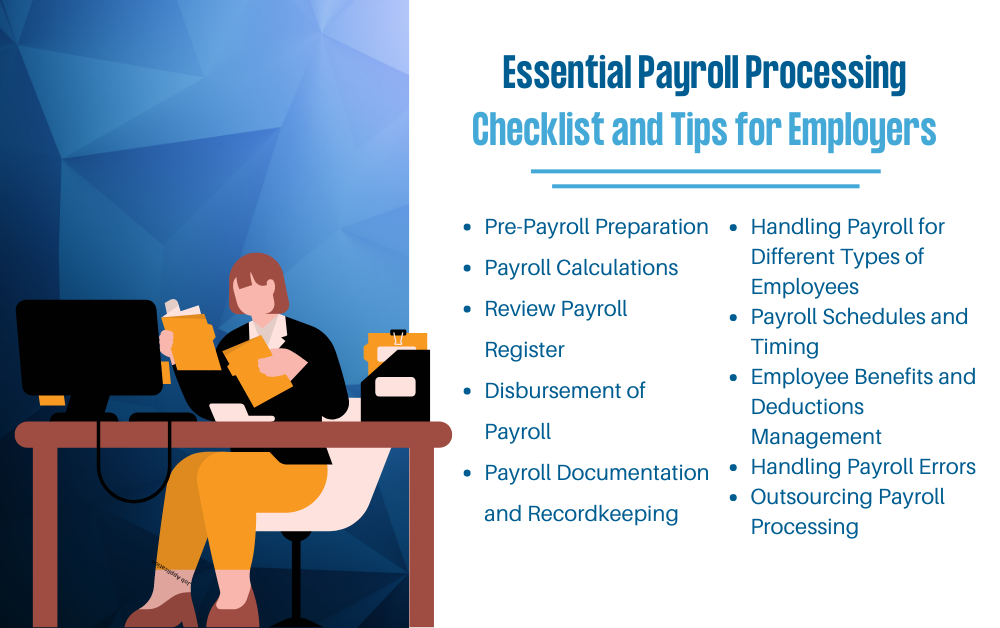Payroll processing is a critical function for any business, ensuring that employees are paid accurately and on time while complying with various tax laws and regulations. Effective payroll not only keeps employees satisfied but also helps avoid legal issues and penalties. However, managing payroll can be complex, involving multiple steps such as updating employee information, calculating pay, and maintaining compliance with tax laws. Given these challenges, having a comprehensive payroll processing checklist is essential for smooth operations. In this blog, we’ll cover a detailed payroll processing checklist and key considerations every employer should keep in mind to streamline their payroll processes.
Pre-Payroll Preparation
Updating Employee Information for Accurate Payroll Processing
One of the first steps in payroll processing is to ensure that all employee information is accurate and up to date. This includes recording new hires, processing terminations, and updating changes in tax status or personal information. Keeping this data current is crucial because any discrepancies can lead to incorrect payroll calculations, causing delays or errors that could affect employee satisfaction and compliance with tax laws.
Verifying Timekeeping Data
Accurate timekeeping is essential for calculating payroll correctly, especially for hourly employees. Ensure that timesheets are filled out accurately, approved by supervisors, and submitted on time. Errors in recording overtime, paid time off (PTO), or sick leave can lead to payroll processing mistakes, resulting in underpayment or overpayment. Investing in a reliable timekeeping system can simplify this process and reduce the chances of errors.
Reviewing Deductions and Benefits
Before running payroll, it is important to review and update any changes in employee benefits, deductions, or contributions. This includes health insurance premiums, retirement plan contributions, and any other deductions. Ensuring that these details are correct is crucial for accurate payroll and helps avoid issues like incorrect tax withholding or benefits deductions.
Payroll Calculations
Calculating Gross Pay
The next step in payroll processing is calculating gross pay, which is the total amount an employee earns before any deductions. For salaried employees, this is generally a fixed amount. For hourly employees, it involves multiplying the number of hours worked by their hourly wage, including any overtime, bonuses, or commissions. Accurate calculation of gross pay is foundational to the entire payroll processing procedure.
Calculating Deductions for Effective Payroll Processing
Once gross pay is determined, the next step in payroll processing is to calculate deductions. Deductions may include federal and state taxes, Social Security, Medicare, health insurance premiums, retirement contributions, and other voluntary or mandatory deductions. It’s important to stay updated on current tax rates and regulations to ensure compliance and avoid penalties.
Determining Net Pay
Net pay is the amount employees take home after all deductions have been made. During the process, this final step involves subtracting all deductions from the gross pay. Providing clear, detailed pay stubs to employees that outline gross pay, deductions, and net pay helps maintain transparency and trust.
Review Payroll Register
Verifying Accuracy in Payroll Processing
A critical part of payroll processing is reviewing the payroll register for each employee to verify accuracy. The payroll register is a summary document that includes all payroll-related details, such as hours worked, pay rates, deductions, and net pay. Double-checking this information helps prevent payroll errors that could lead to financial discrepancies, employee dissatisfaction, and potential legal consequences.
Ensuring Compliance in Payroll Processing
Ensuring compliance with federal and state regulations is crucial during payroll. This involves adhering to tax laws, minimum wage laws, overtime regulations, and any other relevant labor laws. Regular audits of payroll processes and records can help maintain compliance and reduce the risk of penalties.
Disbursement of Payroll
Processing Direct Deposits and Checks in Payroll Processing
Once all calculations are verified, the next step in payroll processing is disbursing payroll through direct deposits or checks. Most companies prefer direct deposit due to its convenience, security, and cost-effectiveness. Ensure that all direct deposit information is accurate and securely processed to prevent delays or errors.
Distributing Pay Stubs for Transparency
Providing employees with pay stubs is a critical step in the payroll processing workflow. Pay stubs should detail the employee’s earnings, deductions, and net pay for the pay period. Transparent payroll helps build trust and allows employees to understand their compensation fully.
Payroll Documentation and Recordkeeping
Maintaining Accurate Records for Payroll Processing
Maintaining accurate and detailed records is essential for efficient payroll processing. Employers are required to keep records of all payroll transactions, including timesheets, pay rates, deductions, and tax filings, for several years. Proper recordkeeping ensures compliance with regulations and provides a reliable reference in case of audits or disputes. A well-organized documentation system can help streamline payroll and reduce the risk of errors.
Creating Reports to Support Payroll Processing
Payroll reports provide valuable insights into payroll expenses, tax liabilities, and employee compensation trends. Regularly generating reports helps businesses stay informed and make data-driven decisions regarding their payroll practices. These reports can also support internal audits and improve the overall payroll processing strategy.
Handling Payroll for Different Types of Employees
Payroll Processing for Salaried vs. Hourly Employees
Payroll processing varies depending on the type of employee. Salaried employees receive a fixed amount regardless of the hours worked, while hourly employees are paid based on the actual hours worked, including any overtime. Ensuring accurate payroll processing for both types of employees requires clear policies, proper time-tracking systems, and a thorough understanding of labor laws.
Contractors vs. Employees in Payroll
Another key consideration in payroll processing is the distinction between contractors and employees. Contractors typically do not have taxes withheld from their pay, and they receive 1099 forms instead of W-2 forms. Misclassifying employees as contractors can lead to significant legal and financial penalties, so it’s crucial to correctly categorize workers and follow the appropriate payroll procedures for each.
Managing Different Pay Types
Different types of compensation, such as bonuses, commissions, and overtime, require special attention during payroll processing. Each pay type may have unique tax implications and reporting requirements, so it’s important to understand these variations and process them correctly to ensure accurate and compliant payroll management.
Payroll Schedules and Timing
Choosing the Right Payroll Frequency
The frequency of payroll—whether weekly, bi-weekly, semi-monthly, or monthly—can significantly impact both the employer and employees. Choosing the right payroll frequency depends on factors such as cash flow, employee preference, and administrative capacity. A consistent and predictable payroll schedule helps maintain employee satisfaction and simplifies payroll processing.
Setting Payroll Processing Deadlines
Establishing and adhering to deadlines for timesheet submissions, payroll processing, and tax filings is essential for timely and accurate payroll management. Missing these deadlines can lead to payroll delays, penalties, and employee dissatisfaction. Clear communication with employees about these deadlines can help ensure a smoother payroll processing experience.
Employee Benefits and Deductions Management
Understanding Pre-Tax vs. Post-Tax Deductions in Payroll
Understanding the difference between pre-tax and post-tax deductions is crucial for accurate payroll processing. Pre-tax deductions, such as health insurance premiums and retirement plan contributions, reduce the taxable income of employees. Post-tax deductions, like Roth 401(k) contributions or wage garnishments, are taken from the employee’s net pay. Correctly managing these deductions ensures compliance and accuracy in payroll processing.
Effectively Managing Employee Benefits
Payroll processing also involves managing employee benefits like health insurance, retirement plans, and other perks. This requires careful coordination between HR and payroll departments to ensure that benefits are accurately deducted and reported. Proper management of benefits is key to maintaining employee satisfaction and avoiding payroll errors.
Handling Payroll Errors
Common Payroll Processing Errors to Avoid
Payroll errors, such as misclassifying employees, incorrect tax withholdings, or not accounting for overtime, can lead to significant issues for both employers and employees. These mistakes can result in legal penalties, financial losses, and reduced employee trust. Identifying and understanding common payroll processing errors is the first step toward preventing them.
Steps for Quick Payroll Error Resolution
Having a clear protocol for addressing payroll errors is essential for maintaining trust and compliance. This involves identifying the error, notifying the affected employee, correcting the mistake, and implementing checks to prevent future occurrences. A proactive approach to resolving payroll processing errors can help maintain a positive work environment and minimize legal risks.
Outsourcing Payroll Processing
Why Consider Outsourcing Payroll?
Outsourcing payroll processing to a specialized provider can offer numerous advantages, such as minimizing errors, ensuring compliance, and saving time. Many businesses find that outsourcing payroll processing allows them to focus on core business functions while ensuring that payroll is handled by experts. This can also reduce the administrative burden and the risk of non-compliance.
Choosing the Right Payroll Service Provider
When deciding to outsource payroll processing, it’s important to choose a provider that aligns with your business needs. Factors to consider include the cost of services, the range of services offered (such as tax filing and benefits administration), customer support, and the provider’s reputation. A reliable payroll processing partner can help streamline your payroll operations and ensure compliance.
Recapping the Importance of Efficient Payroll
Effective payroll processing is vital for any business, impacting everything from employee satisfaction to compliance with legal requirements. By following a comprehensive payroll processing checklist and understanding key considerations, employers can ensure accurate, timely, and compliant payroll management. To optimize your payroll processing and avoid common pitfalls, consider consulting with a payroll specialist or investing in reliable payroll software. Streamlined payroll can lead to smoother operations, happier employees, and fewer compliance headaches.
Explore Payroll Processing Solutions Today!
If you’re looking for ways to simplify your payroll processing, explore professional services or software solutions tailored to your business needs. Get started today to ensure your payroll is accurate, compliant, and efficient.

